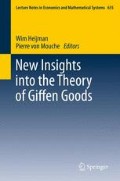Abstract
We consider Giffen goods for the very general setting of an upper semi-continuous utility function. Two not equivalent definitions for this notions are discussed. Concerning this we show that there exists a (well-defined) non-decreasing demand function \({\mathbb{R}}_{++} \rightarrow \mathbb{R}\) that is nowhere strictly increasing. Also we reconsider the relation between Giffen and inferior goods.
Access this chapter
Tax calculation will be finalised at checkout
Purchases are for personal use only
Notes
- 1.
Indeed: for subsets A and B of \(\mathbb{R}\), A ≤ B means a ≤ b (a ∈ A, b ∈ B) and A < B means a < b (a ∈ A, b ∈ B).
- 2.
But also see Exercise 2.F.13 in [5].
- 3.
‘Nowhere monotone’ means that there is no non-degenerate interval on which the function is monotone.
- 4.
- 5.
We do not discriminate between a set with one element (i.e. a singleton) and the element itself.
- 6.
That is, a subset of \({\mathbb{R}}_{++}\) with \(\#\mathcal{P}\geq 2\).
- 7.
Indeed: suppose good i is not Giffen. This implies that for every \(({\mathbf{p}}_{\hat{\imath }}; m)\) and price section \(\mathcal{P}\) good i is not Giffen on \(\mathcal{P}\) at \(({\mathbf{p}}_{\hat{\imath }}; m)\). In particular for every p i ′ < p i and \(({\mathbf{p}}_{\hat{\imath }}; m)\), \(\breve{{x}}_{i}({p}_{i}\prime ) <\breve{ {x}}_{i}({p}_{i})\) does not hold. So, because \(\#\breve{{x}}_{i}(p) = 1\;(p > 0)\), we have for every p i ′ < p i and \(({\mathbf{p}}_{\hat{\imath }}; m)\) that \(\breve{{x}}_{i}({p}_{i}\prime ) \geq \breve{ {x}}_{i}({p}_{i})\). It follows for every \(({\mathbf{p}}_{\hat{\imath }}; m)\) that good i is ordinary on \({\mathbb{R}}_{++}\) at \(({\mathbf{p}}_{\hat{\imath }}; m)\). Thus good i is ordinary.
- 8.
Here is a proof by contradiction: so suppose u is Giffen. Then there is some price section \(\mathcal{P}\) and budget m such that good 1 is Giffen on \(\mathcal{P}\) at m. Let \({p}_{a},{p}_{b}\,\in \,\mathcal{P}\) with p a < p b . Then \(\breve{{x}}_{1}({p}_{a}) <\breve{ {x}}_{1}({p}_{b})\).
Because of the upper semi-continuity of u the maximum v(p; m) of † p; m is well-defined. Because \(\breve{{x}}_{i}({p}_{b}) \subseteq [0,m/{p}_{b}] \subseteq [0,m/{p}_{a}]\), it follows that, v(p b ; m) < v(p a ; m). Because \(\breve{{x}}_{1}({p}_{a}) <\breve{ {x}}_{1}({p}_{b})\), it follows that \(\breve{{x}}_{1}({p}_{a}) \subseteq [0,m/{p}_{b}]\) and therefore v(p a ; m) < v(p b ; m), a contradiction.
- 9.
See the contribution [2] in this book for an overview of concrete Giffen utility functions with various theoretical properties.
- 10.
That is, a subset of \({\mathbb{R}}_{+}\) with \(\#\mathcal{M}\geq 2\).
- 11.
Here is a proof by contradiction. Suppose u is inferior. Then there is a budget section \(\mathcal{M}\) and price p 1 such that good 1 is inferior on \(\mathcal{M}\) at p 1. Let \({m}_{a},\;{m}_{b} \in \mathcal{M}\) with m a < m b . Then \(\hat{{x}}_{1}({m}_{a}) >\hat{ {x}}_{1}({m}_{b})\). Because \(\hat{{x}}_{1}({m}_{a}) \subseteq [0,{m}_{a}/{p}_{1}] \subseteq [0,{m}_{b}/p]\), it follows that v(p; m a ) < v(p; m b ). Because \(\hat{{x}}_{1}({m}_{b}) <\hat{ {x}}_{1}({m}_{a})\), it follows that \(\hat{{x}}_{1}({m}_{b}) \subseteq [0,{m}_{a}/p]\) and therefore v(p; m b ) < v(p; m a ), a contradiction.
- 12.
Here is a proof by contradiction. Suppose \(\inf \mathcal{M}\leq 0\). Then \(\inf \mathcal{M} = 0\). Take \({m}_{0} \in \mathcal{M}\) with \(\hat{{x}}_{i}({m}_{0}) > 0\). Because \(\inf \mathcal{M} = 0\) and \(\min ({p}_{i}\hat{{x}}_{i}({m}_{0}),{m}_{0}) > 0\), there is \(m \in \mathcal{M}\) with \(m <\min ({p}_{i}\hat{{x}}_{i}({m}_{0}),{m}_{0})\). Now \({p}_{i}\hat{{x}}_{i}({m}_{0}) > m \geq {p}_{i} \cdot \hat{ {x}}_{i}(m) > {p}_{i}\hat{{x}}_{i}({m}_{0})\), a contradiction.
- 13.
Also see Example 8 in the contribution [2] in this book.
- 14.
Note that m′≥ 0.
- 15.
We use for \(\mathbf{x},\mathbf{y} \in {\mathbb{R}}^{2}\) the notation \({I}_{[\mathbf{x},\mathbf{y}]}\; :=\;\{ (1 - \lambda )\mathbf{x} + \lambda \mathbf{y}\;\vert \;0 \leq \lambda \leq 1\}\).
- 16.
Even with the following additional properties: \(\vert F\prime (x)\vert \leq 1\;(x \in \mathbb{R})\), \(\{x \in \mathbb{R}\;\vert \;F\prime (x) = 0\}\) is dense in \(\mathbb{R}\) and F′ is over no interval Riemann-integrable.
- 17.
For if F(a) > F(b), then replace F by − F. And if F(a) = F(b), there is always a constant c with a < c < b with F(a)≠F(c). Now replace F(x) by \(\tilde{F}(x)\; :=\; \left (a\frac{b-c} {b-a} + \frac{c-a} {b-a}x\right )\). Now \(\tilde{F}(a) = F(a)\neq F(c) =\tilde{ F}b\). If \(\tilde{F}(a) >\tilde{ F}(b)\), then replace \(\tilde{F}\) by \(-\tilde{F}\).
References
I. Dasgupta and P. K. Pattanaik. Comparative statics for a consumer with multiple optimum consumption bundles. IZA Discussion Paper 4818, Institute for the Study of Labor, Bonn, 2010.
W. Heijman and P. H. M. von Mouche. A child garden of concrete Giffen utility functions: a theoretical review. 655:69–88, 2011.
Y. Katznelson and K. Stromberg. Everywhere differentiable, nowhere monotone, functions. American Mathematical Monthly, 81:349–353, 1974.
H. Liebhafsky. New thoughts about inferior goods. American Economic Review, 59:931–934, 1969.
A. Mas-Colell, M. D. Whinston, and J. R. Green. Microeconomic Theory. Oxford University Press, New York, 1995.
A. van Rooy and W. Schikhof. A Second Course on Real Functions. Cambridge University Press, Cambridge, 1982.
P. Sørenson. Giffen demand for several goods. 655:97–104, 2011.
Author information
Authors and Affiliations
Corresponding author
Editor information
Editors and Affiliations
Rights and permissions
Copyright information
© 2012 Springer Berlin Heidelberg
About this chapter
Cite this chapter
von Mouche, P., Pijnappel, W. (2012). On the Definitions of Giffen and Inferior Goods. In: Heijman, W., von Mouche, P. (eds) New Insights into the Theory of Giffen Goods. Lecture Notes in Economics and Mathematical Systems, vol 655. Springer, Berlin, Heidelberg. https://doi.org/10.1007/978-3-642-21777-7_4
Download citation
DOI: https://doi.org/10.1007/978-3-642-21777-7_4
Published:
Publisher Name: Springer, Berlin, Heidelberg
Print ISBN: 978-3-642-21776-0
Online ISBN: 978-3-642-21777-7
eBook Packages: Business and EconomicsEconomics and Finance (R0)

